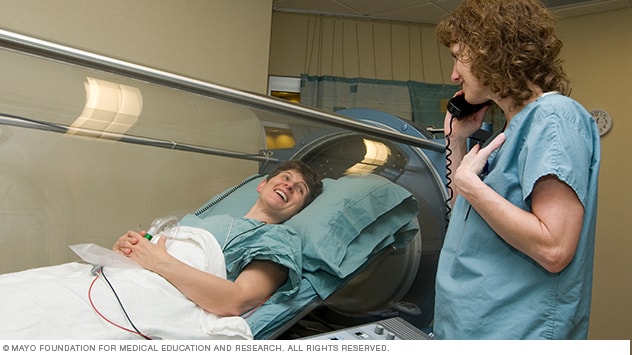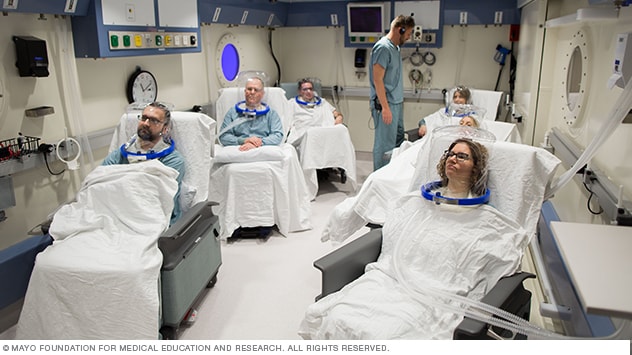Overview
Hyperbaric oxygen therapy involves breathing pure oxygen in a pressurized environment. Hyperbaric oxygen therapy is a well-established treatment for decompression sickness, a potential risk of scuba diving. Other conditions treated with hyperbaric oxygen therapy include:
- Serious infections.
- Bubbles of air in blood vessels.
- Wounds that may not heal because of diabetes or radiation injury.
In a hyperbaric oxygen therapy chamber, the air pressure is increased 2 to 3 times higher than normal air pressure. Under these conditions, your lungs can gather much more oxygen than would be possible breathing pure oxygen at normal air pressure.
This extra oxygen helps fight bacteria. It also triggers the release of substances called growth factors and stem cells, which promote healing.
Products & Services
Why it's done
Your body's tissues need an adequate supply of oxygen to function. When tissue is injured, it requires even more oxygen to survive. Hyperbaric oxygen therapy increases the amount of oxygen your blood can carry. With repeated treatments, the temporary extra high oxygen levels encourage normal tissue oxygen levels, even after the therapy is completed.
Hyperbaric oxygen therapy is used to treat several medical conditions. And medical institutions use it in different ways. Your health care provider may suggest hyperbaric oxygen therapy if you have one of the following conditions:
- Severe anemia.
- Brain abscess.
- Bubbles of air in your blood vessels, known as arterial gas embolism.
- Burns.
- Carbon monoxide poisoning.
- Crushing injury.
- Deafness, sudden.
- Decompression sickness.
- Gangrene.
- Infection of skin or bone that causes tissue death.
- Nonhealing wounds, such as a diabetic foot ulcer.
- Radiation injury.
- Skin graft or skin flap at risk of tissue death.
- Vision loss, sudden and painless.
Risks
Hyperbaric oxygen therapy is generally a safe procedure. Complications are rare. But this treatment does carry some risk.
Potential risks include:
- Middle ear injuries, including leaking fluid and eardrum rupture, due to changes in air pressure.
- Temporary nearsightedness, called myopia, caused by temporary eye lens changes.
- Lung collapse caused by air pressure changes, called barotrauma.
- Seizures as a result of too much oxygen, also called oxygen toxicity, in your central nervous system.
- Lowered blood sugar in people who have diabetes treated with insulin.
- In certain circumstances, fire — due to the oxygen-rich environment of the treatment chamber.
How you prepare
You'll be provided with a hospital-approved gown or scrubs to wear in place of regular clothing during the procedure.
For your safety, items such as lighters or battery-powered devices that generate heat are not allowed into the hyperbaric chamber. You also may need to remove hair and skin care products that are petroleum based, as they are a potential fire hazard. Your health care team will provide instruction on preparing you to undergo hyperbaric oxygen therapy.
What you can expect
During hyperbaric oxygen therapy
Individual hyperbaric oxygen unit, also called monoplace hyperbaric oxygen unit

Individual hyperbaric oxygen unit, also called monoplace hyperbaric oxygen unit
In a one-person hyperbaric oxygen unit, a person rests inside a clear plastic tube and receives treatment. This is called a monoplace chamber.
Hyperbaric oxygen therapy room

Hyperbaric oxygen therapy room
Hyperbaric oxygen therapy also can be given to more than one person in a large room. In this case, each person gets oxygen through a lightweight, clear hood.
Hyperbaric oxygen therapy typically is performed as an outpatient procedure but also can be provided while you are hospitalized.
In general, there are two types of hyperbaric oxygen chambers:
- A unit designed for one person. In an individual unit, you lie down on a table that slides into a clear plastic chamber. This is known as a monoplace unit.
- A room designed to accommodate several people. A multiperson hyperbaric oxygen room usually looks like a large hospital room. You may sit or lie down during treatment. You may receive oxygen through a mask over your face or a lightweight, clear hood placed over your head.
Whether you're in an individual or multiperson environment for hyperbaric oxygen therapy, the benefits are the same.
During therapy, the air pressure in the room is about 2 to 3 times higher than normal air pressure. The increased air pressure will create a temporary feeling of fullness in your ears. This is similar to what you might feel in an airplane or at a high elevation. You can relieve that feeling by yawning or swallowing.
For most conditions, hyperbaric oxygen therapy lasts approximately two hours. Members of your health care team will monitor you and the therapy unit throughout your treatment.
After hyperbaric oxygen therapy
Your therapy team will check you after your session. A team member may look in your ears and take your blood pressure and pulse. If you have diabetes, your blood glucose is checked. Once the team decides you are ready, you can get dressed and leave.
You may feel somewhat tired or hungry following your treatment. Hyperbaric oxygen therapy doesn't limit activities.
Results
To benefit from hyperbaric oxygen therapy, you'll likely need more than one session. The number of sessions depends upon your medical condition. Some conditions, such as carbon monoxide poisoning, might be treated in three visits. Others, such as nonhealing wounds, may require 40 treatments or more.
To effectively treat approved medical conditions, hyperbaric oxygen therapy is usually part of a broad treatment plan. This plan may include other therapies and medicines that are designed to fit your unique needs.
Dec. 02, 2023